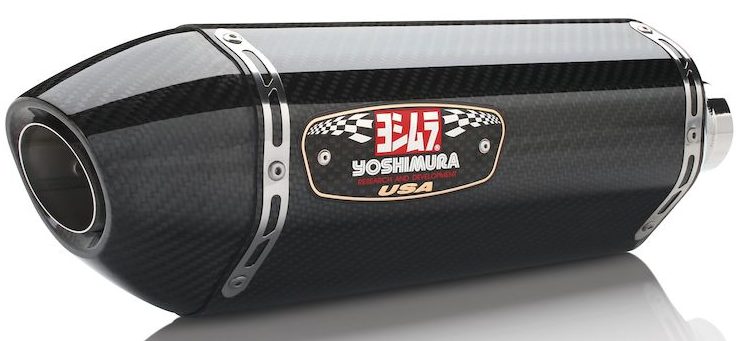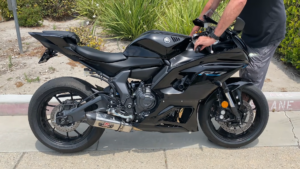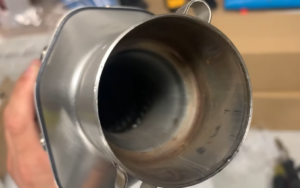This is my buying guide on the best exhausts for the Kawsaki Ninja 300 in 2024. Below is a quick summary of my top recommendations. Scroll further down to read in depth, hands on reviews for each exhaust.

LeoVince LV-10 Slip-On Exhaust
- Stainless steel build
- 4.6 pounds
- Sandblasted end cap
- Matte black
- Laser cut bracket
- Affordable
- Light weight
- Trusted brand
- Compact dimensions
- Very strong levels of torque
- Specifically designed for sport bikes
- Simple installation
- Great aesthetic
- Deep sounding purr

Yoshimura R77 Slip-On Exhaust
- Designed specifically for racers
- Light weight
- Maximise speed
- Maximises higher rpm
- Significant level of sound
- Produced in the USA
- Carbon fibre end cap
- Overwhelmingly positive customer reviews
- Great aesthetic
- high-flow trapezoidal shape
- Stainless steel
- Bolt on installation
- Bike specific
- Deep tone
- Easy and simple installation

Motorcycle Slip-On Exhaust
- Made from aluminum and stainless steel
- 6 monthly warranty
- Removable baffle
- Compatible with all variations of the Ninja 300
- Cheap option
- Decent aesthetic
- Overwhelmingly positive customer reviews
- Lighter than stock exhaust
- Easy installation
- Adjustable sound
- Comes with curved pipe
- Great aesthetic
I was on a quest to find the best exhaust for the Kawasaki Ninja 300, and I knew this wouldn’t be an easy task. The stock exhausts on most Ninjas have always bugged me – they’re both inefficient and have this higher-pitched purr that doesn’t even remotely match the tenacity of a high-speed street bike. So, I took it upon myself to dig deep and compile the best exhausts for the Ninja 300.
My garage soon became an exhaust testing lab. I went through various exhausts, meticulously analyzing them for build quality, sound, longevity, price, brand trustworthiness, and more. I turned every nut, bolt, and examined every curve to understand how each part played a role in the overall performance.
In the sea of options, the LeoVince LV-10 stood out as the best slip-on exhaust for the Ninja 300. Its performance, aesthetics, and quality were unmatched. But if a full system was what you were after, I couldn’t overlook Akrapovic’s racing exhaust system. The way it breathed new life into the Ninja 300 was nothing short of exhilarating.
However, as I delved into the details, I realized an essential factor that anyone considering this change must know. You must double-check the fitment and specifications. The Ninja 300 comes in a variety of variations, and it’s incredibly easy to mix them up. When choosing a motorcycle exhaust where fitment is crucial, you can’t afford to overlook this aspect.
So, if you’re a Ninja 300 owner and you’ve felt that disconnect between the bike’s appearance and its exhaust’s sound, know that you’re not alone. But with careful consideration and attention to detail, you can find the exhaust that makes your Ninja roar the way it’s meant to. It’s a journey well worth taking, and I hope my hands-on experience can guide you through it.
IMPORTANT! – Make sure you have the correct Exhaust sizing and fitment so you don’t waste your money.
Best Slip-On Exhausts For The Ninja 300
I remember the day I first came across Yoshimura, one of the most well-known exhaust manufacturers in the world. Their connection to professional racing fascinated me, and as I dove deeper into their work, I realized that their exhausts are built with the hands-on experience and wisdom of real racers.
You see, Yoshimura actually has a professional racing team, and it’s not just for show. The racers’ opinions and insights directly shape the design and production of the exhausts. If you’re like me, someone who’s intrigued by racing and looking to maximize high speeds, this translates into some of the best exhausts you can find.
One exhaust that caught my eye was the R77. I wanted something designed for casual motorcyclists but still maintaining the essence of a racing exhaust. The R77, built mostly from stainless steel with a carbon fiber end cap, seemed to strike the perfect balance between durability and weight reduction. I’ve seen fellow riders shy away from carbon fiber due to the cost and the risk of damage in a crash, but here was an exhaust that seemed to mitigate that concern.
But what about the performance? I know that if an exhaust leans toward either torque or high speeds, there’s usually a trade-off. With the R77, I found that it was a racing exhaust that improved top speeds, which would mean a decrease in torque. Yet, from my research and personal experience, I knew it would still outperform the stock exhaust at the end of the day.
The promise of extra performance at top speeds and higher revs appealed to me, especially for my Ninja 300. I found out that the R77 achieves this with its lighter weight and high flow trapezoidal design. In simpler terms, it was all about maximizing high speeds.
The installation? I was pleasantly surprised to discover that it was specific to my Ninja 300 and used a bolt-on installation system. Even for a novice rider like myself, it seemed super simple.
But the sound, oh, the sound! Yoshimura understands that for enthusiasts like me, the sound of an exhaust can be a deal-breaker. The R77 delivered a deep, natural putter that wasn’t excessively loud but hit that sweet spot where everyone on the road would know I was there.
After all my research, testing, and tinkering, I knew the R77 was my #1 recommendation for the best Kawasaki Ninja 300 exhausts. Yes, it was above the affordable range, but the benefits were worth it. It’s not just a product recommendation; it’s a passion and an experience that I can’t wait to share with fellow riders who want to find that perfect exhaust for their bike. If you’re looking for more affordable options, keep reading, but I assure you the R77 has something special that’s hard to match.
Pros
- Designed specifically for racers
- Light weight
- Maximise speed
- Maximises higher rpm
- Significant level of sound
- Produced in the USA
- Carbon fibre end cap
- Overwhelmingly positive customer reviews
- Great aesthetic
- high-flow trapezoidal shape
- Stainless steel
- Bolt on installation
- Bike specific
- Deep tone
- Easy and simple installation
Cons
- Increases speed at the cost of torque
- Pricey
- Bike specific exhaust
- Maximises performance requires a full system
I won’t beat around the bush: I’ve sung the praises of LeoVince’s LV-10 slip-on exhausts in so many articles, it’s almost a love affair. Why? Because they’ve consistently been my go-to choice for an all-around best exhaust, especially if you’re looking for something that doesn’t skimp on quality but doesn’t empty your wallet either.
Allow me to take you back to my second motorcycle, a white 2014 Ninja 300 that I picked up second hand. She was a beauty, but her stock exhaust was in need of an upgrade. That’s when I found the Leo Vince LV-10, and back then, I had nothing but good things to say about it. Now, all this time later, my opinion hasn’t changed much.
Let me tell you why: this is a well-built exhaust that sounds great and also shaves off a lot of excess weight, thanks to its stainless steel construction. Weighing in at only 4.6 pounds, this exhaust is incredibly light. Pair it with some aftermarket piping, and you’ll notice a significant weight reduction on your Ninja 300.
You see, LeoVince has spent years focusing on exhausts for racing and sports bikes. In my experience, manufacturers that hone in on a specific area tend to truly master their craft. In this case, LeoVince’s choice of stainless steel is just perfect for street riders like myself. Why? Because stainless steel strikes that ideal balance. It’s lightweight yet durable, not as featherweight as carbon fiber, but a lot stronger. It might not be as robust as titanium, but it sure is lighter. For a street motorcycle like the Ninja 300, it’s the Goldilocks of materials.
But what about the power benefits of the LV-10? The first thing you’ll notice is its compact size. It’s shorter than most slip-ons, and the diameter of the pipe is smaller. For city riders like me, this makes a world of difference in torque and how quickly I can rev up from a standstill. Most of us aren’t aiming for top speeds or maxing out RPMs on city roads, so an exhaust that emphasizes torque over higher speed just makes sense.
Finally, let’s get to the sound of this thing. It’s more than decent; it’s got a nice, deep purr. Honestly, it won’t compare to a full system exhaust, but for what it is, it certainly doesn’t disappoint.
So there you have it: a personal endorsement of the LV-10 from someone who’s not only written about it but experienced it firsthand. It’s more than just an affordable exhaust; it’s a part of my riding journey and one that I’m confident could enhance yours too.
Pros
- Stainless steel build
- 4.6 pounds
- Sandblasted end cap
- Matte black
- Laser cut bracket
- Affordable
- Light weight
- Trusted brand
- Compact dimensions
- Very strong levels of torque
- Specifically designed for sport bikes
- Simple installation
- Great aesthetic
- Deep sounding purr
Cons
- Favours torque but at the cost of higher rpm
- Some riders dislike the look of the compact design
I remember the days when I was first getting into motorcycles, young and, like most folks at that age, strapped for cash. Believe me, I get it. Not everyone, especially those just starting out, can afford to shell out big money for a brand new exhaust. So let me share a personal recommendation for those of you in the same boat.
Now, I want to talk about a super cheap option that’s not as bad as you might think. This is a no-brand exhaust off Amazon, and while I haven’t used it personally, I’ve got friends who have it installed on their bikes. They swear it’s a decent exhaust for how cheap it is.
I usually don’t recommend purchasing exhausts from a general store like Amazon, as most of what’s for sale can be cheaply made with poor longevity. Imagine having it break mid-ride! But this particular exhaust, produced by Ransoto, is different. It’s the best you can get for the Ninja 300 at this price point, even though I must admit I’m not so familiar with the manufacturer.
Given that it’s a budget option, it’s made of a mix of aluminum and stainless steel, which is expected at this price. What really caught my eye about this exhaust is the feedback from people I know. They say it’s decent, but more importantly, it’s managed to gather a heap of overwhelmingly positive customer reviews online.
I’ve taken the time to listen to the sound of this exhaust through a few different videos, and I’d say it’s alright. At this price point, you can’t expect a deep roar or purr like more expensive options, so it may not completely satisfy those who prioritize the sound of the exhaust. But for the cost-conscious, it’s something you can make do with.
When it comes to performance benefits, it’s a bit tricky to pinpoint. This exhaust doesn’t come from a prominent racing company, and there’s been no solid testing to back it up. It is noticeably lighter than the stock exhausts most Ninjas come with, so there will be some performance gains, but exactly how much? I honestly can’t say for sure.
Overall, though, I have to give Ransoto some credit. They’ve created a respectable budget exhaust that’s worth a look, especially considering the price point. How long it will last is still up in the air, but the positive customer reviews give me confidence that it comes with decent longevity. If you’re like I was back in the day, pinching pennies but hungry for a better exhaust, this just might be the solution for you.
Pros
- Made from aluminum and stainless steel
- 6 monthly warranty
- Removable baffle
- Compatible with all variations of the Ninja 300
- Cheap option
- Decent aesthetic
- Overwhelmingly positive customer reviews
- Lighter than stock exhaust
- Easy installation
- Adjustable sound
- Comes with curved pipe
- Great aesthetic
Cons
- Questionable quality
- Unknown brand
- Lacks instructions
Best Full-System Exhausts For The Ninja 300
I’ve talked before about how a full system exhaust for your Ninja 300 can maximize various performance factors, and I stand by the claim that it’s the most value you can squeeze from a single motorcycle part. But let me be clear: full system exhausts can be quite the investment, and when you’re dealing with the core systems of your motorcycle, cutting corners just isn’t an option.
That said, I found a gem that strikes the perfect balance in LeoVince’s GP Corsa. In my hunt for the best full system exhaust for a Ninja 300, this one really hit the sweet spot, especially considering it’s an affordable option. Trust me, full system exhausts usually come with a crazy price tag, but LeoVince managed to pack a ton of improvements into this system without making it cost a fortune.
Now, let’s talk about sound. The GP Corsa is loud – and I mean really loud. While I personally loved the deep roar, I have to admit that it can wear on you during a long ride. Thankfully, the sound can be adjusted. Without the baffle, it was a bit too much for me, but once installed, it was just right. The level of decibels is high, and there’s no doubt everyone on the road will know you’re coming. This makes it an ideal choice for city riding, where navigating tight lanes and busy traffic demands attention.
But where the GP Corsa truly shines is in performance. One of the reasons I love full system exhausts is the significant weight reduction when switching from stock, and that translates to noticeable gains in top speeds and torque. With a combination of stainless steel and carbon fiber, the GP Corsa is both durable and lightweight. I’ve even witnessed it survive a mild crash when a friend came off his bike – the exhaust held up and didn’t need replacement.
Unless you’re looking exclusively for a racing exhaust, the GP Corsa fits the bill for all types of riders by marrying durability with a pleasing weight reduction.
And now, onto the performance benefits. Assuming you’re replacing a stock exhaust system, you’re in for some power improvements across the board. Though I wasn’t completely certain if the Corsa leans more towards torque or top speeds, what I did feel was a smoother ride with noticeably higher RPMs and quicker acceleration. Some may argue these benefits stem from the weight reduction, but whatever the reason, the difference is palpable.
In my eyes, LeoVince’s GP Corsa is a valuable addition to the Ninja 300. It delivers on performance, sounds incredible, and won’t break the bank. If you’re looking to upgrade your exhaust without skimping on quality, this might just be the perfect match for you.
Pros
- Developed specifically for lower CC motorcycles
- Heat resistant fiberglass
- Produced using stainless steel
- Round design
- Bolt on install
- Reduces huge amounts of weight
- High quality stainless steel
- Guaranteed longevity
- Exhaust gas flow
- Enhanced sound flow
- Works with stock fuel settings
- Improves all levels of engine performance
- Nice aesthetic
- Awesome sounding
- Affordable
- Durable
Cons
- More difficult installation
- Not cheap
- Arguably to loud for long rides
- Without the baffle arguably to loud
Should you choose a full system or slip-on exhaust for your Ninja 300?
Choosing between a full system or a slip-on exhaust for my Ninja was the first big decision I had to face. What would be the better fit? I weighed the pros and cons of both, understanding that the right choice would ultimately come down to my personal preference as a rider.
Going with a full system exhaust, I knew I would maximize performance, cut weight, and even see an improvement in fuel efficiency. Of all the parts and accessories I could invest in for my bike, the full system exhaust promised the most bang for my buck. In comparison, a slip-on exhaust, while providing the second most value for money, wouldn’t quite take things to the same level. Both options had their merits, but the full system would simply unlock the full potential of a high-quality exhaust.
However, the problem with opting for a full system exhaust wasn’t lost on me: it was going to be pricier and possibly challenging for me to install. There was no room for error; it had to be done right. But I realized that if I found myself in over my head, I could take the full system to a mechanic and have it installed professionally. It wouldn’t take them long or cost me much, so that gave me some peace of mind.
On the flip side, I considered the slip-on exhaust. Sure, it would help me drop some weight and offer performance gains, along with potentially better fuel efficiency. But it wouldn’t reach the same heights as a full system. The significant advantage of the slip-on, though, was its affordability, and even as a novice rider, I knew I could handle the installation myself.
In the end, the decision between a full system or slip-on exhaust wasn’t just about cost and performance. It was a deeply personal choice, reflecting my own skills, needs, and ambitions as a rider. Whether maximizing benefits with a full system or opting for the more affordable and manageable slip-on, I knew either choice would bring a fresh breath of life to my Ninja.
What if I want a full system exhaust but I can’t afford it?
I found myself in a fortunate situation when I wanted to upgrade my bike’s exhaust but was on a tight budget. I learned that I could actually purchase a slip-on exhaust first, and then later, when I had some extra cash, buy the internal piping for my motorcycle.
I hadn’t realized this before, but many times the only difference between a manufacturer’s full system and slip-on exhaust is how the slip-on is attached directly to the piping. This realization allowed me to go ahead and purchase the slip-on first and then add the pipes later on when I could afford it.
I must admit, depending on the complexity of the installation, I knew I might need the help of a mechanic down the road. But for the time being, this step-by-step approach not only fit my budget but also let me gradually upgrade my bike to a full system without having to commit to the whole expense upfront. It was a hands-on experience that gave me more flexibility and control over my bike’s improvements.

















